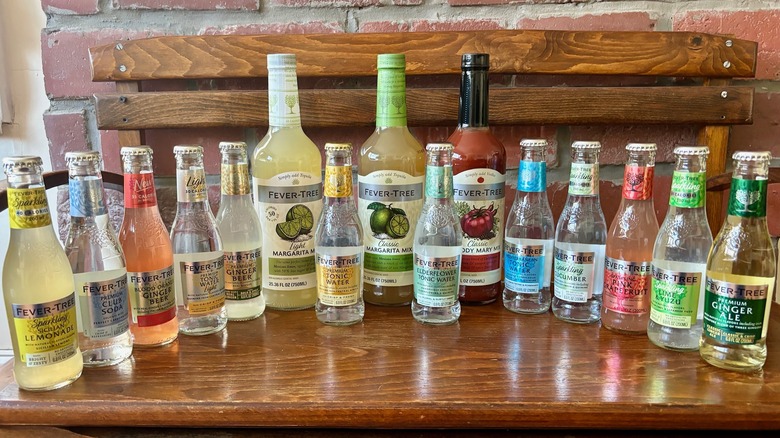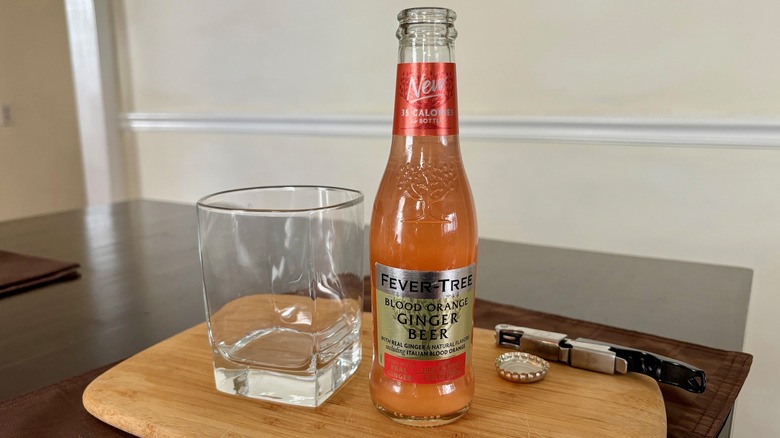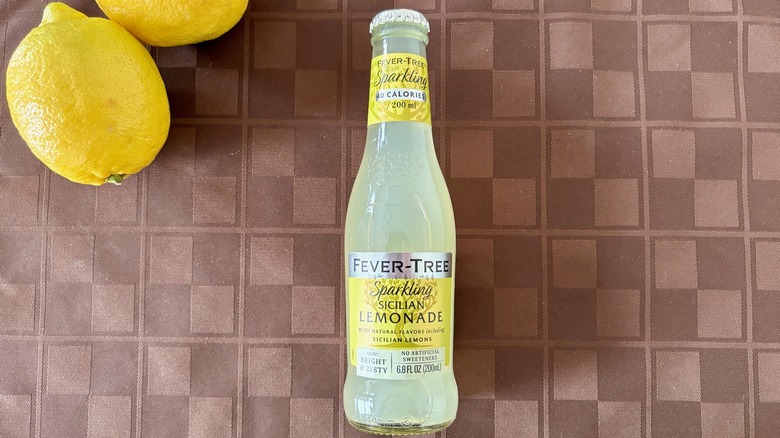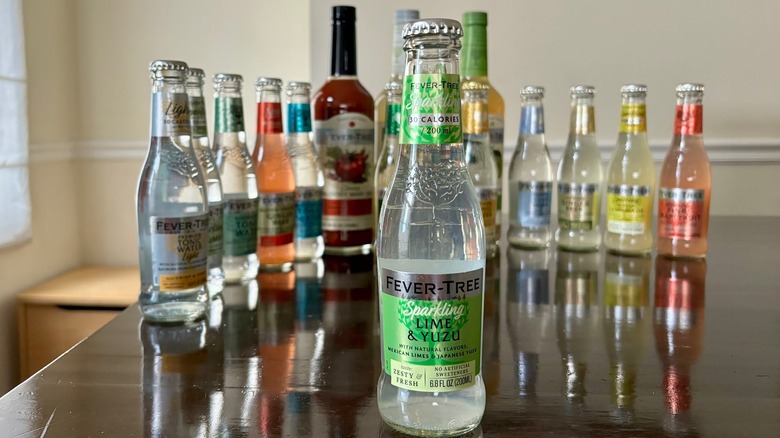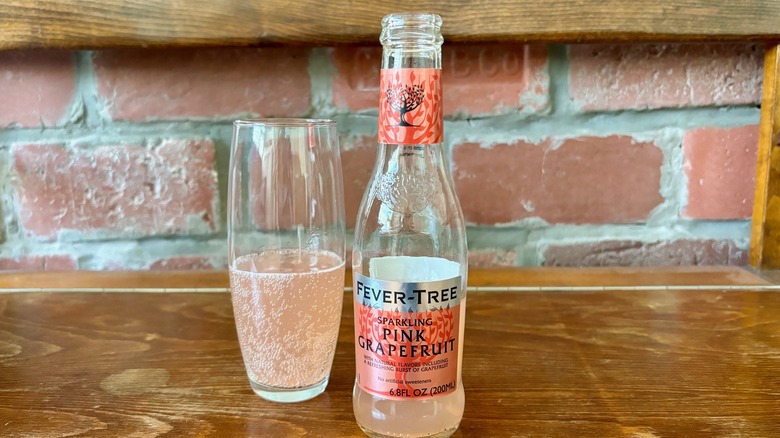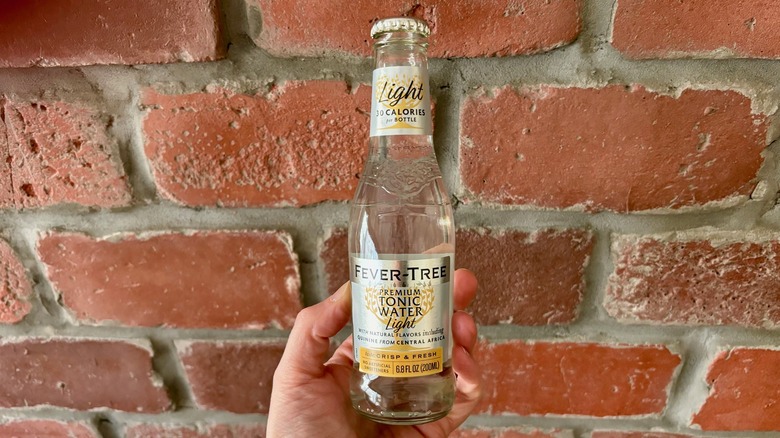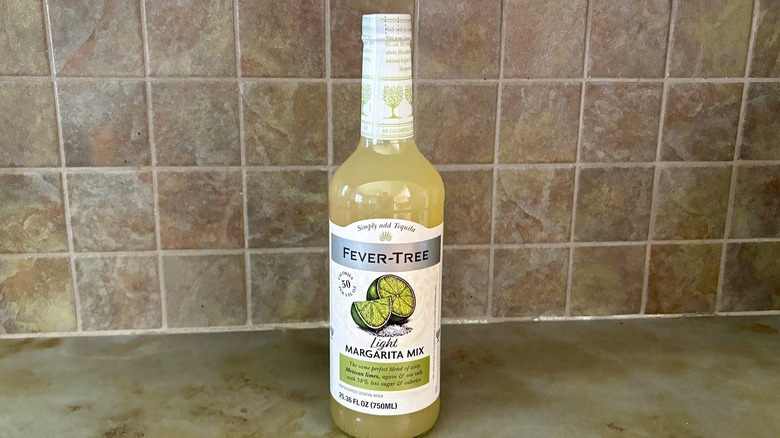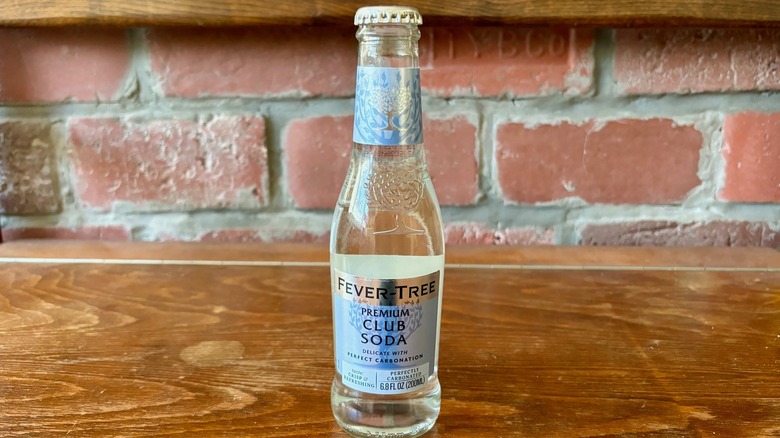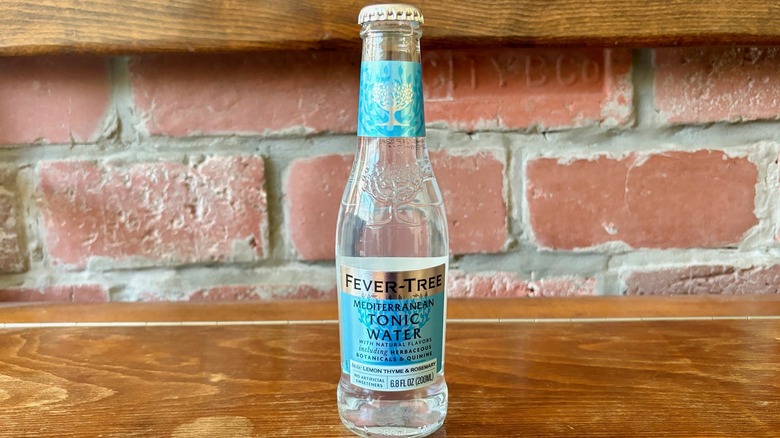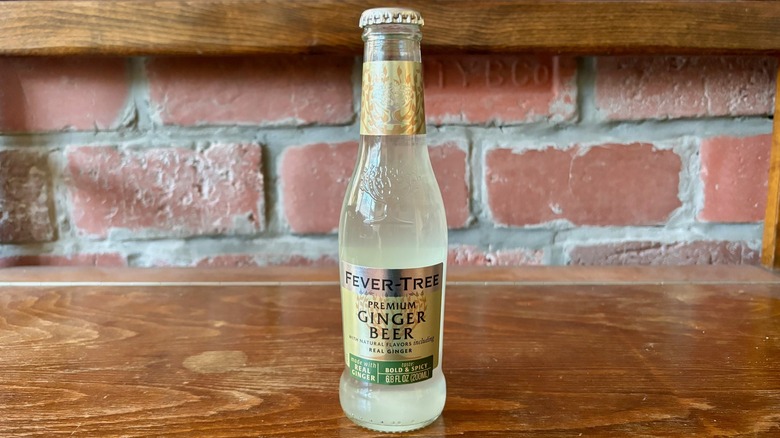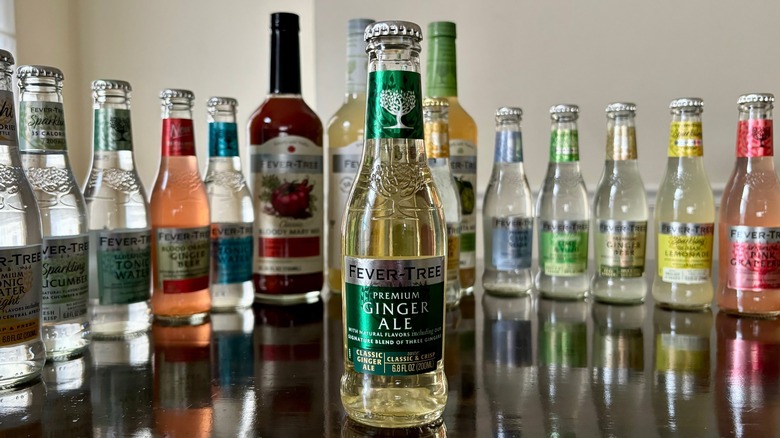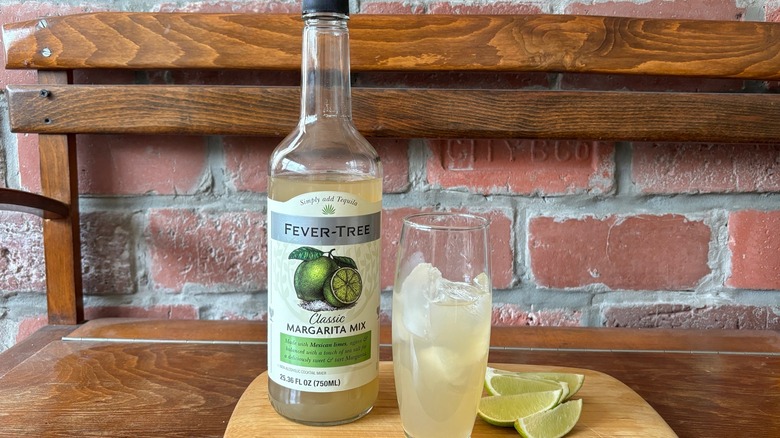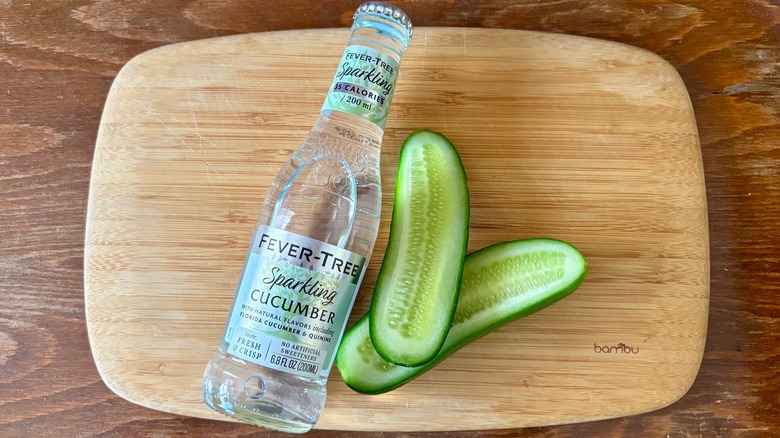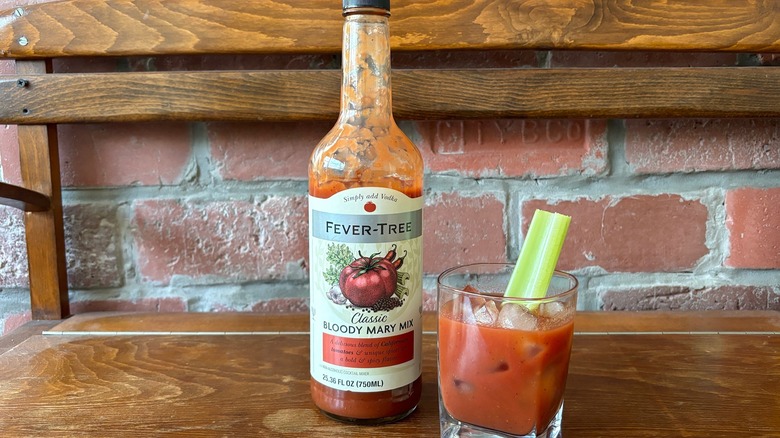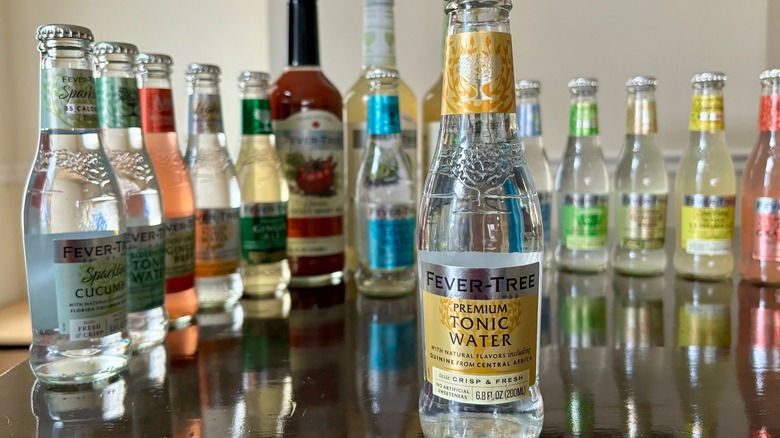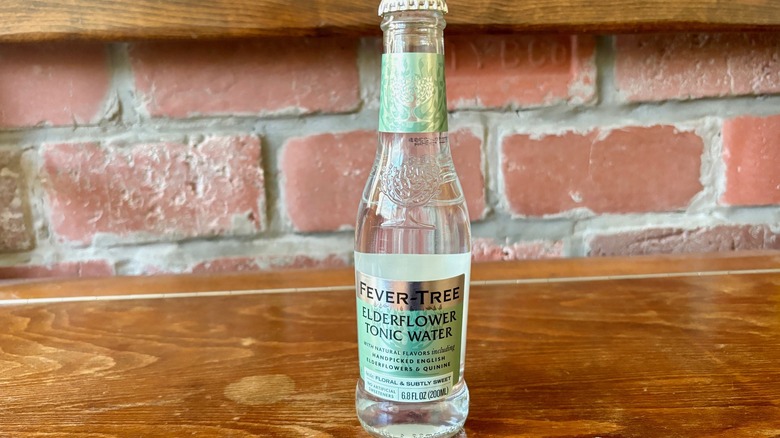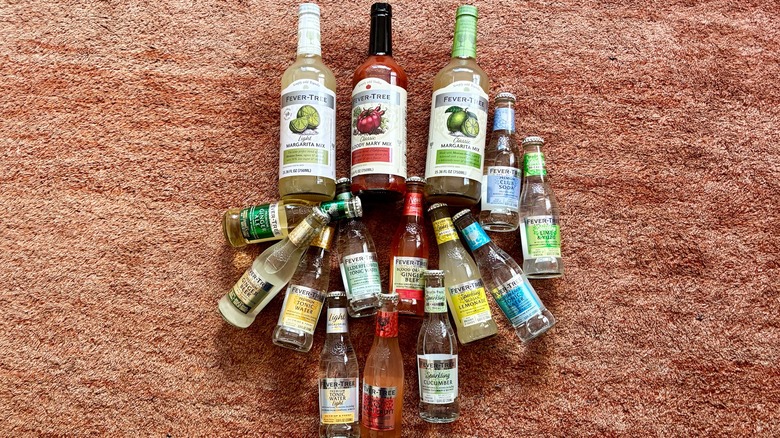15 Fever-Tree Mixers, Ranked
Choosing a mixer for a cocktail doesn't have to be complicated. Sometimes, seltzer plus the spirit of your choice is enough. But, if you have ever wondered why a professionally mixed cocktail is superior to what you whip up at home, take a closer look at your mixers. Neutral spirits can pair with everything from pineapple juice to espresso, but a really good cocktail goes beyond one-note tastes and crafts layers of complementary and contrasting flavor notes. This is where Fever-Tree comes in.
Fever-Tree is the brainchild of two men who realized in the early 2000s that although people were starting to pay attention to the quality of spirits they chose, there were not enough top mixers to go with them. The gap in the market led them to create Fever-Tree's first product in 2005, Premium Indian Tonic Water. The company now offers mixers in five categories: tonic waters, cola, sparklings, gingers, and cocktail mixers. Fever-Tree sent us 15 varieties to sample and rank so you can make your next cocktail the best yet. We ranked based on overall taste and their function as a mixer.
All recommendations are based on first-hand impressions. Promotional materials and products were provided by the manufacturer and distributor for sampling.
15. Blood Orange Ginger Beer
Blood Orange Ginger Beer is a dramatic twist on ginger beer that blends blood oranges from Italy with spicy ginger. Blood oranges are different from navel oranges in both flavor and color. Blood oranges have a unique red color ranging from mildly red to deep, almost purple. The citrus flavor in this drink comes from blood orange flavoring and natural lime flavor.
This mixer has a saturated pinkish-orange color, like the sky on a perfect sunset. However, the aroma is ginger-heavy and doesn't hint at the citrus in the drink. The taste has the hallmark slow burn of a ginger beer with robust ginger flavor and spiciness, but instead of a sweet-tart or juicy orange flavor, the drink has a heavy perfume-like taste. There is a whisper of orange at the end of each sip, but it is not enough to cut through the ginger or make it identifiable as a blood orange drink. This mixer ranked low because of the discrepancy between the name and taste of the drink, coupled with the harsh unbalanced flavor.
14. Sparkling Sicilian Lemonade
Lemon is featured in countless classic cocktails, including a Tom Collins and Lemon Drop Martini, so having a lemon-based mixer from Fever-Tree makes a lot of sense. Fever-Tree's Sparkling Sicilian Lemonade is made of sugar, lemons from concentrate, natural lemon flavor, citric acid, and ascorbic acid. To get the flavor from Sicilian lemons, they used a process common to perfume-making called sfumatrice, which allows Fever-Tree to extract oils from both the peel and juice of the lemon.
The pale-yellow, slightly cloudy mixer has a strong lemon aroma, which isn't surprising. But the intense bitterness in the taste is a shock. This is a far cry from the sweet-tart summer beverage one might expect from lemonade. The bitterness sets in quickly and lingers well after taking a sip. With the lemon flavor coming from extracted oils, it veers closer to a lemon household cleaner than a refreshing drink. The overall unpleasant taste caused this mixer to rank low.
13. Sparkling Lime & Yuzu
The Fever-Tree product line hits on many different citrus fruits, like lemon, lime, and orange, and this variety goes a bit further to include yuzu, a citrus fruit that is very popular in Japan. Yuzu looks like a cross between an orange and a lemon but has a sharp taste closer to a grapefruit. The limes in this drink are Tahiti limes sourced from Mexico. Fever-Tree suggested vodka, tequila, or mezcal as a pairing.
The description of this mixer sounds complex, fun, and delicious, but the initial aroma is a let-down. It mostly smells like lime juice, and not fresh lime juice, but like a can of frozen concentrate. Sparkling Yuzu & Lime isn't overly sweet, but it also isn't deeply flavored. There is a lack of body to the drink, and coupled with not being able to taste the yuzu, it is basically diluted sparkling limeade. It is hard to imagine the flavor standing up to a smoky mezcal, but even a simple vodka would only further the diluted taste. This mixer isn't unpalatable, but it's also not very special.
12. Sparkling Pink Grapefruit
Fever-Tree suggests tequila or vodka to pair with this pretty pink citrusy drink, which makes sense since a Greyhound and Palomas are well-loved grapefruit-based cocktails featuring those spirits. There are red and pink grapefruit juices in the ingredients in addition to natural grapefruit flavoring.
Sparkling Pink Grapefruit has a fresh and bitter grapefruit smell, like the air after peeling a piece of fruit when the oils from the rind spritz up and perfume the room. The flavor is more delicate. After the fine bubbles on the tongue soften, a subtly sweet grapefruit flavor comes forward. However, more than tasting like the fruit, the drink tastes like a piece of lightly candied grapefruit peel with a heavy bitter quality. Though this mixer does sort of taste like grapefruit, the strong bitterness is the dominant flavor, and it makes it less than ideal as a mixer. The combination of factors keeps this drink from ranking higher.
11. Light Premium Tonic Water
Fever-Tree's Light Premium Tonic Water is a lower-calorie version of its Premium Tonic Water. The main difference is in one ingredient. To reduce the calories, fructose is used instead of sugar. This change drops the calories from 70 to 30 per 200 milliliter bottle.
Light Premium Tonic has a similar citrusy aroma as the regular tonic, though it is not as strong. The bottle also has an unexpected toasted sugar smell reminiscent of cotton candy. Despite that sugary smell, the tonic does not taste sweet. Both the bitterness and overall flavor are mild. The fructose does have an aftertaste that lingers on the back of the palate, but unless you are particularly sensitive to it, the taste would be easily masked with a spirit or a squeeze of fresh citrus. It is a great tonic choice for someone looking for a light, spritzy drink or who prefers a gentle bitterness.
10. Light Margarita Mix
Light Margarita Mix is very similar to the classic version. Both mixers are sweetened with cane sugar and agave syrup, but the light version has 50 calories per serving, which is significantly less than the classic. Light Margarita Mix has lime extract and grapefruit oil in the ingredient list, which is not part of the classic formula. Otherwise, the components are the same.
The color is a soft greenish-yellow and is slightly cloudy in appearance. Lime dominates the aroma, but there is also a sharpness from citric acid that detracts from the purity of the citrus. The flavor is pleasantly tart, but it is also heavily bitter, which is unexpected and less than ideal. It has a light body, perhaps due to the lesser amount of sugars, and though it's not watery per se, it feels lacking. When choosing a light mixer, you may be compromising on a few aspects, but you don't want to feel you are settling. Ultimately, that is how this mixer drinks. While still handy to have on hand for a fast, low-calorie cocktail, it doesn't hold up as well in the ranking as others.
9. Premium Club Soda
The difference between club soda and seltzer is minor and significant at the same time, especially when considering its role in a cocktail. Fever-Tree notes that what makes its club soda stand out is the balance of high carbonation and light flavor. If you are questioning what flavor water can have, the sodium bicarbonate in the ingredient list is the answer. Sodium bicarbonate adds a small amount of sodium in addition to a slight earthy taste.
Fever-Tree Club Soda has large bubbles that pop on the tongue and audibly burst from the surface of a glass. It's hard to describe what something minerally is like, but it evokes wet soil or water babbling over smooth river stones. The big question is whether there is a benefit to using club soda versus another bubbly water. While seltzer will offer pure dilution with some bubbles, as there is no detectable flavor, club soda should be considered if a hint of salt is intended to lift up your cocktail. This mixer lands in the middle of the pack because although it has its benefits, they are subtle.
8. Mediterranean Tonic Water
Mediterranean Tonic Water differs from Premium Tonic Water in a few ways. The botanicals in Mediterranean Tonic Water include notes of rosemary and lemon thyme, there is less quinine, and it is sweetened with fructose instead of sugar. These differences aim to create a more aromatic and less intense tonic for someone looking for more flavor but less bitterness.
There is a very different aroma to this tonic versus the Premium Tonic. Citrus is still at the forefront of the aroma, but there are floral notes as well. The bitterness is minimal, setting in after the botanical flavor and quickly dissipating. There are plenty of small, bright bubbles in the carbonation, but they do not burn. This is a very light and refreshing tonic ideal for someone who finds other tonic waters too sweet or sharp or someone looking to sip on a tonic without a spike of a spirit.
7. Ginger Beer
Fever-Tree sources its ginger from three different places in Africa and India, allowing each type of ginger to add a unique flavor and aroma to the finished drink. Ginger Beer is different from ginger ale, and despite the name, it does not contain alcohol. In general, you can expect a more robust flavor from ginger beer, and Fever-Tree's Ginger Beer is no exception.
You don't need to get close to get a punch of ginger wafting from the bottle. There is a bold, fresh ginger scent that only gets more intense as you get closer to taking a sip. Besides the expected ginger flavor, the bright, tingling carbonation was the first thing we noticed. As that faded, the spiciness of the ginger moved in and started a low burning in our mouths. There is just enough sweetness to balance the drink, but it's not nearly as sweet as a soda. Overall, it has a nice balance and could just as easily be sipped over ice as spiked with a dark rum or bourbon.
6. Ginger Ale
Like the ginger beer, three different types of ginger go into Fever-Tree's Ginger Ale. The company suggests that it can be enjoyed on its own, similar to a soda, or paired with a spirit, preferably something dark like whisky or rum. This mixer has a rich, clear, golden-yellow hue that comes from caramel color in the ingredient list.
There is a bright burst of ginger on the palate and just a hint of sharpness that keeps the sweet drink from tasting overly sugary. It does not taste hot or spicy, but it is not mild either. Some brands of ginger ale taste more like sugar water with a hint of flavor, but this is a ginger-forward drink. It lands perfectly between enough ginger to live true to its name and be refreshing and delicious and the line where ginger can start to taste artificial or medicinal. It is a delightful option for a ginger-based cocktail or sipping alone as a full-flavored, sophisticated neverage.
5. Classic Margarita Mix
This mixer brings classic margarita ingredients together, along with a few surprises. In addition to lime juice, sugar, agave, and salt in the ingredients, there are orange extract and bitters. A 4-ounce serving is 120 calories (before the recommended tequila or mezcal). Fever-Tree recommends a ratio of 1½ ounces of tequila per 4 ounces of the mixer.
If you are someone who orders a margarita with extra lime wedges or prefers sour candy to regular, this is the mixer for you. The drink smells predominantly of bottled lime juice, but the flavor absolutely explodes. It is sweet, sour, bright, and sharp all at the same time. At the end of each sip is a hint of bitterness that tastes like lime peel, which adds another layer of deep lime flavor and keeps the drink from tasting cloying or one-note. The intense pucker of the mixer does soften as the ice dilutes it, but it still retains a very tasty full flavor and makes it an excellent option for a margarita mixer.
4. Sparkling Cucumber
Thanks to the addition of quinine, this sparkling drink is closer to a tonic than a seltzer. The cucumber flavor comes from natural flavoring. The other ingredients include fructose, citric acid, and natural lemon flavoring.
From the second you open the bottle, there is no doubt this is a cucumber-based drink. The aroma is big and smells just like freshly cut, juicy cucumbers. The slight bitterness from the quinine and acidity from the lemon cut the taste of the cucumber just enough so that it doesn't skew vegetal and stays crisp and refreshing.
Sparkling Cucumber would be a fantastic addition to a spritz on a hot summer day or to put a twist on a classic drink like a gin tonic or vodka soda. Sticking to lighter spirits lets the cucumber flavor come through the drink, and complimenting herbs, like mint or basil, are a welcome addition. The superb, bright, fresh flavor and versatility as a mixer give this a solid spot in the top five.
3. Bloody Mary Mix
Fever-Tree's Bloody Mary Mix is not short on ingredients. The label boasts that the mixer is a strongly flavored combination of California tomatoes and spices, and considering all the flavorings, from garlic and allspice to shiitake mushroom powder, it is easy to believe it. The mixer also has several classic bloody mary ingredients, including Worcestershire sauce, celery seed, black pepper, lemon, cayenne, and horseradish. Bloody Mary Mix is sold in a 750-milliliter bottle and holds enough to make 6 cocktails if following the recommended ratio of a 4-ounce mixer to 1½ ounce vodka pour.
The tomato-rich aroma is packed with flavor notes signaling the forthcoming peppery, sharp taste. The mixer requires some dilution as the tomato paste base is too thick to sip without it. Once it is thinned, all the flavors open up, and you taste fresh ripe tomatoes with just a hint of sweetness, the bright pop of vinegar and lemon, savory notes from the Worcestershire, and the slow lingering burn of the cayenne, black pepper, and horseradish. It is not too salty, and there is no risk of it becoming watery. It tastes like a homemade mixer without needing an entire bag of ingredients.
2. Premium Tonic Water
The signature bitterness in tonic water comes from quinine, a product of the bark of the cinchona tree. Like any plant-driven product (wine, coffee, olive oil), the location of the plant will impact the final flavor. The founders of Fever-Tree researched cinchona trees before finding the ideal source in the Democratic Republic of Congo. Premium Tonic Water is sold in three different sizes. The ingredients contain sugar, citric acid, and natural flavors that include quinine and bitter orange oil sourced from Mexico.
The aroma is sweet and citrusy, almost like a lemon-lime soda, though in the first sip, it becomes clear this is no soda. Though very crisp and bubbly, the tonic does not taste sweet, and it only takes a second for the acerbity to settle in. Even after swallowing, the bitterness continues to bloom and expand on the palate before slowly fading. As it exits, the final taste is a little citrusy pucker that pulls behind the back teeth. The sugar acts as a counterbalance to the tartness while enhancing the citrus. Tonic isn't a flavor for everyone but offers a wonderful depth that pairs so well with spirits, and this tonic is a delicious choice.
1. Elderflower Tonic
Fever-Tree recommends vodka or gin to balance the light flavor of elderflower in this tonic water. People may be familiar with elderflower liqueur, but elderflowers can be used to craft other products as well. For Elderflower Tonic Water, Fever-Tree sources fresh elderflowers from England and distills them. The resulting elderflower oil is what is used to flavor this drink. The other ingredients include fructose, citric acid, and flavorings, including quinine.
Elderflower has a delicate but specific flavor, somewhere between a pear and a melon, with a kiss of floral and citrus notes. It is both juicy and aromatic, which increases the appeal and ability that this Fever-Tree mixer has to pair with spirits. The tonic is a little sweeter than some of the other mixers in this ranking, but it is still far from syrupy and overall incredibly balanced in its basic profile. The sweetness also helps offset the moderate bitterness, which offers complexity but does not dominate. Overall, this mixer is spot on in every way and is as delicious, sipped directly from the bottle as part of a cocktail.
Our Methodology
To determine the rankings taste was the most important factor. Each mixer was chilled and tasted several times, which allowed me to judge the initial carbonation and first wave of flavors and pick up on deeper nuances once some of the fizz settled. Although I did not mix any of these with alcohol, a good mixer should not need alcohol to improve it. For the three specific cocktail mixers, I poured them over ice and let them gently dilute for a few minutes to approximate the same dilution that would happen with a spirit.
I've been learning about cocktails for years, but my appreciation for them took longer. I took a bartending class in college, memorizing ratios and ingredient combinations, but I didn't enjoy actually drinking them. Over time, as I furthered my exposure to good cocktails and later developed many of my own recipes for various media outlets, I began to understand and appreciate how a good cocktail is more than the sum of its parts, but oh, do the parts matter.
